🔍 Forensic Science: Essential Concepts for Reading Comprehension
Forensic science applies scientific principles and techniques to solve crimes and uncover evidence admissible in court. It integrates multiple disciplines, from biology to digital technology, to reconstruct events and identify perpetrators. RC passages on this topic often explore the methods, challenges, and innovations in forensic investigations. Understanding these concepts enables readers to critically analyze how science supports the justice system.
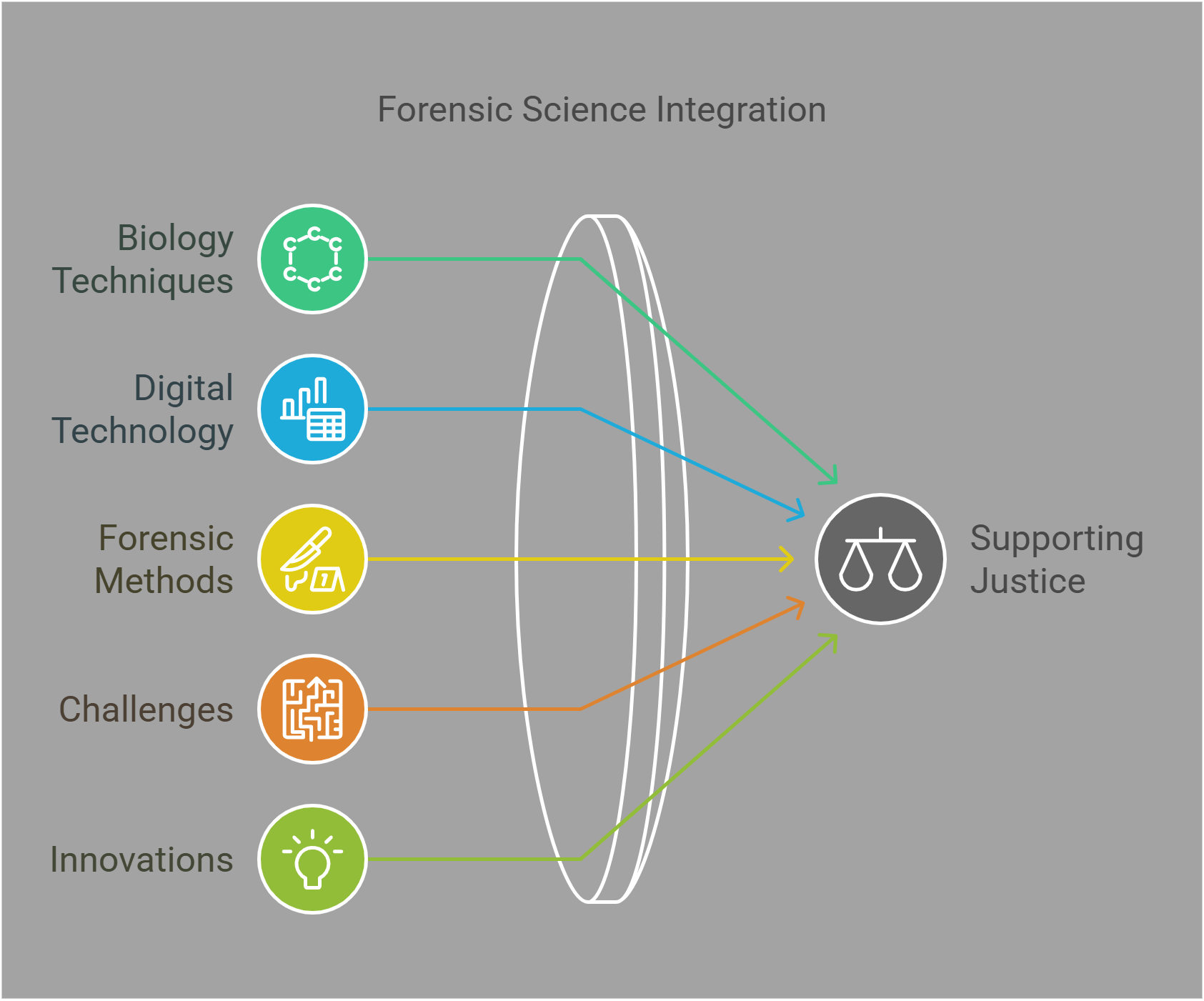
📋 Key Concepts
This guide explores the following essential concepts in forensic science:
- DNA Fingerprinting
- Forensic Anthropology
- Crime Scene Investigation
- Ballistics
- Toxicology
- Trace Evidence
- Digital Forensics
- Post-Mortem Analysis
- Chain of Custody
- Blood Spatter Analysis
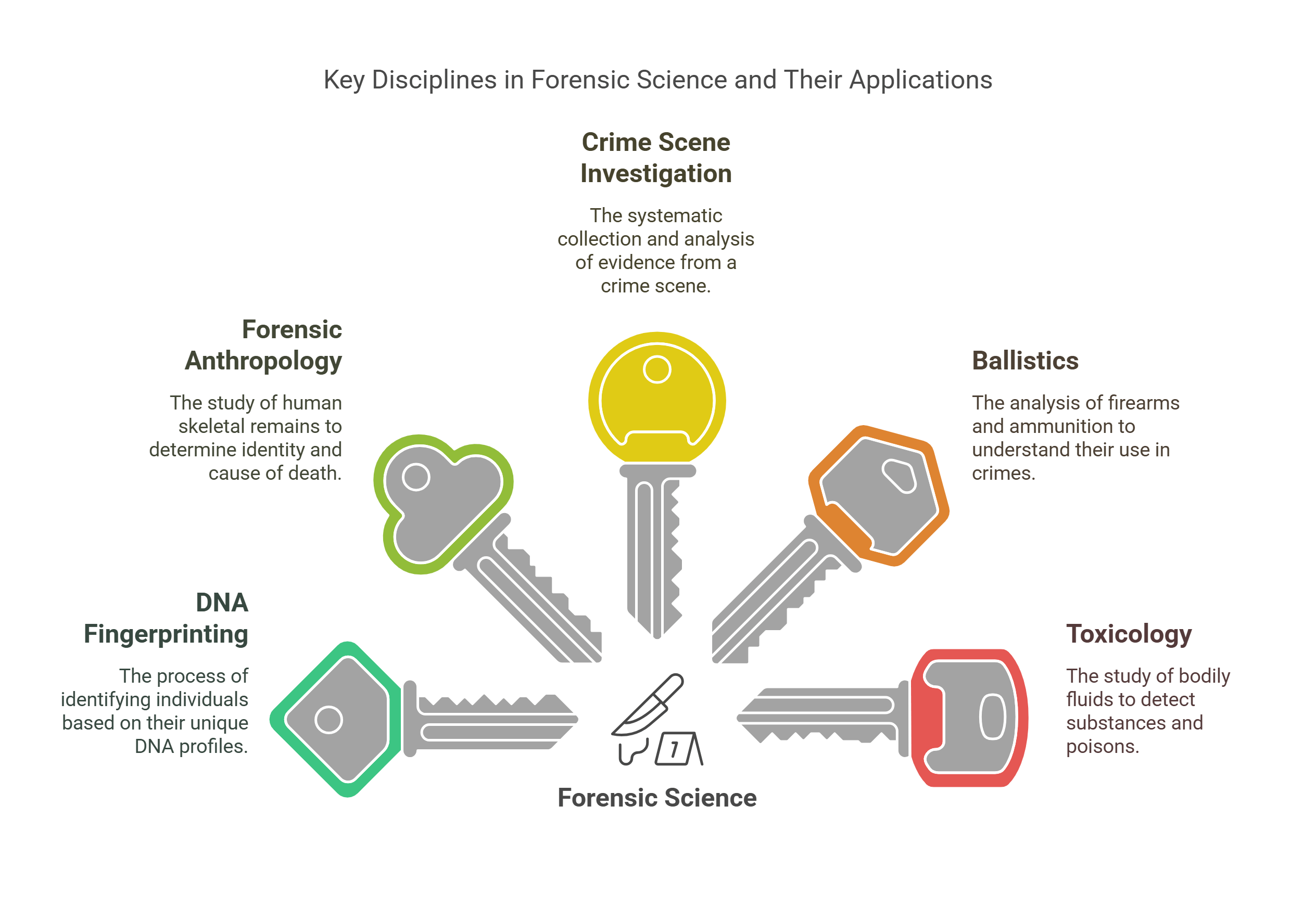
🔍 Detailed Explanations
1. DNA Fingerprinting
DNA fingerprinting, or DNA profiling, is a technique used to identify individuals based on their unique genetic patterns. It is highly accurate and often serves as critical evidence in criminal and civil cases.
- Process:
- Collecting DNA samples (e.g., blood, hair, saliva).
- Extracting DNA and amplifying specific regions using Polymerase Chain Reaction (PCR).
- Comparing DNA patterns through gel electrophoresis or database matching.
- Applications:
- Identifying suspects or exonerating wrongfully accused individuals.
- Establishing paternity or kinship.
- Identifying remains in mass disasters.
Example: DNA evidence helped convict serial killer Ted Bundy by linking him to crime scenes.
Explained Simply: DNA fingerprinting is like finding a unique barcode in your genes to identify you with precision.
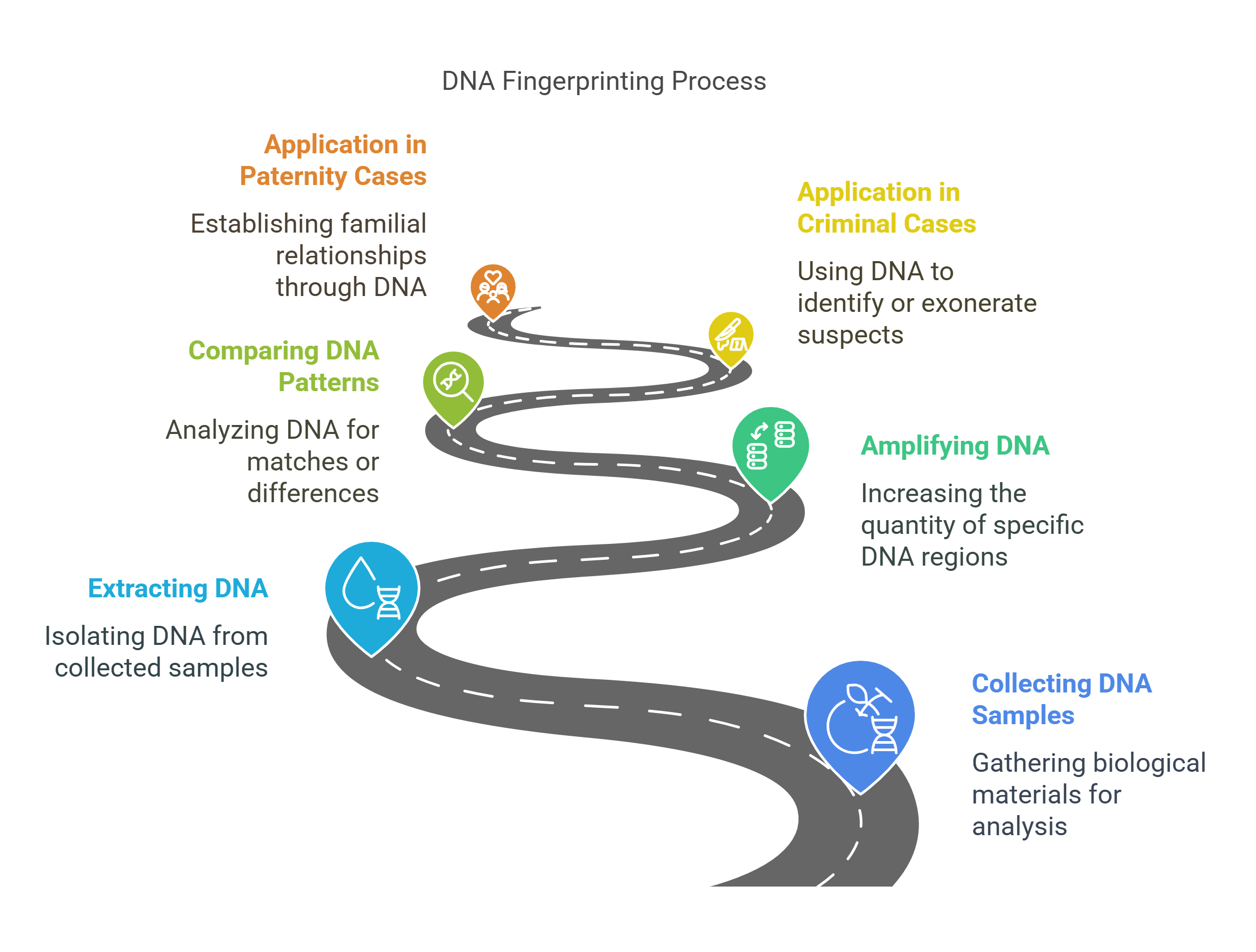
2. Forensic Anthropology
Forensic anthropology involves analyzing human skeletal remains to determine identity and cause of death. It is used in cases involving decomposed, burned, or incomplete remains.
- Key Applications:
- Estimating age, sex, and ancestry of the deceased.
- Identifying trauma, such as fractures or bullet wounds.
- Reconstructing facial features from skulls for identification.
- Challenges:
- Distinguishing between post-mortem damage and injuries caused before death.
- Accurately determining the timeline of decomposition.
Example: Forensic anthropologists played a crucial role in identifying victims from mass graves in post-conflict zones.
Explained Simply: Forensic anthropology is like reading the story of a life written in bones.
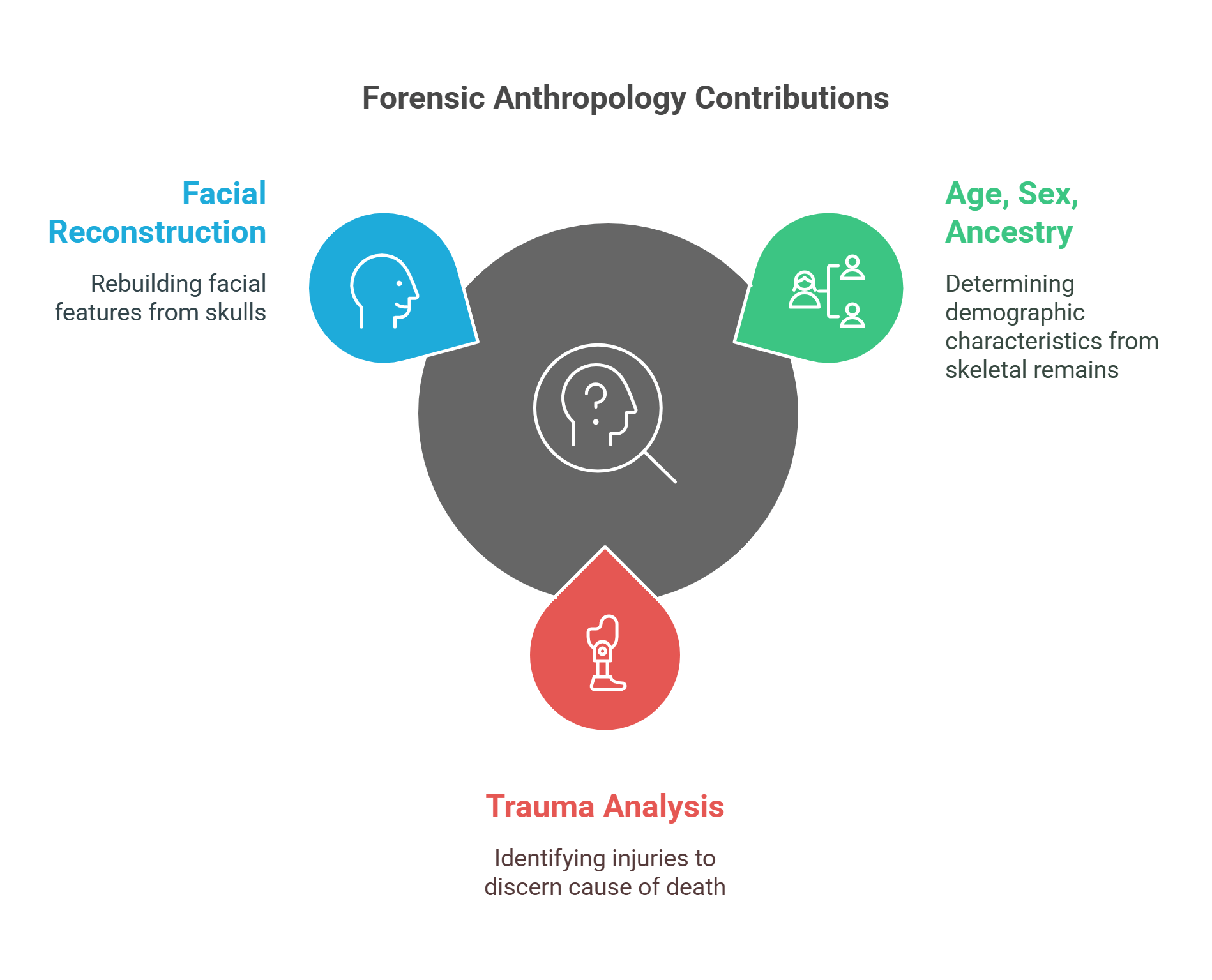
3. Crime Scene Investigation
Crime scene investigation (CSI) involves systematically examining and collecting physical evidence from a crime scene to reconstruct events and identify perpetrators.
- Key Steps:
- Securing the scene to prevent contamination.
- Documenting the scene through photographs, sketches, and notes.
- Collecting evidence, such as fingerprints, blood samples, or weapons.
- Preserving evidence for lab analysis.
- Importance:
- Ensures evidence integrity and maintains the chain of custody.
- Provides clues about the sequence of events and the perpetrator’s actions.
Example: In the O.J. Simpson case, improper crime scene handling led to controversy over evidence admissibility.
Explained Simply: Crime scene investigation is like piecing together a puzzle using every clue left behind.
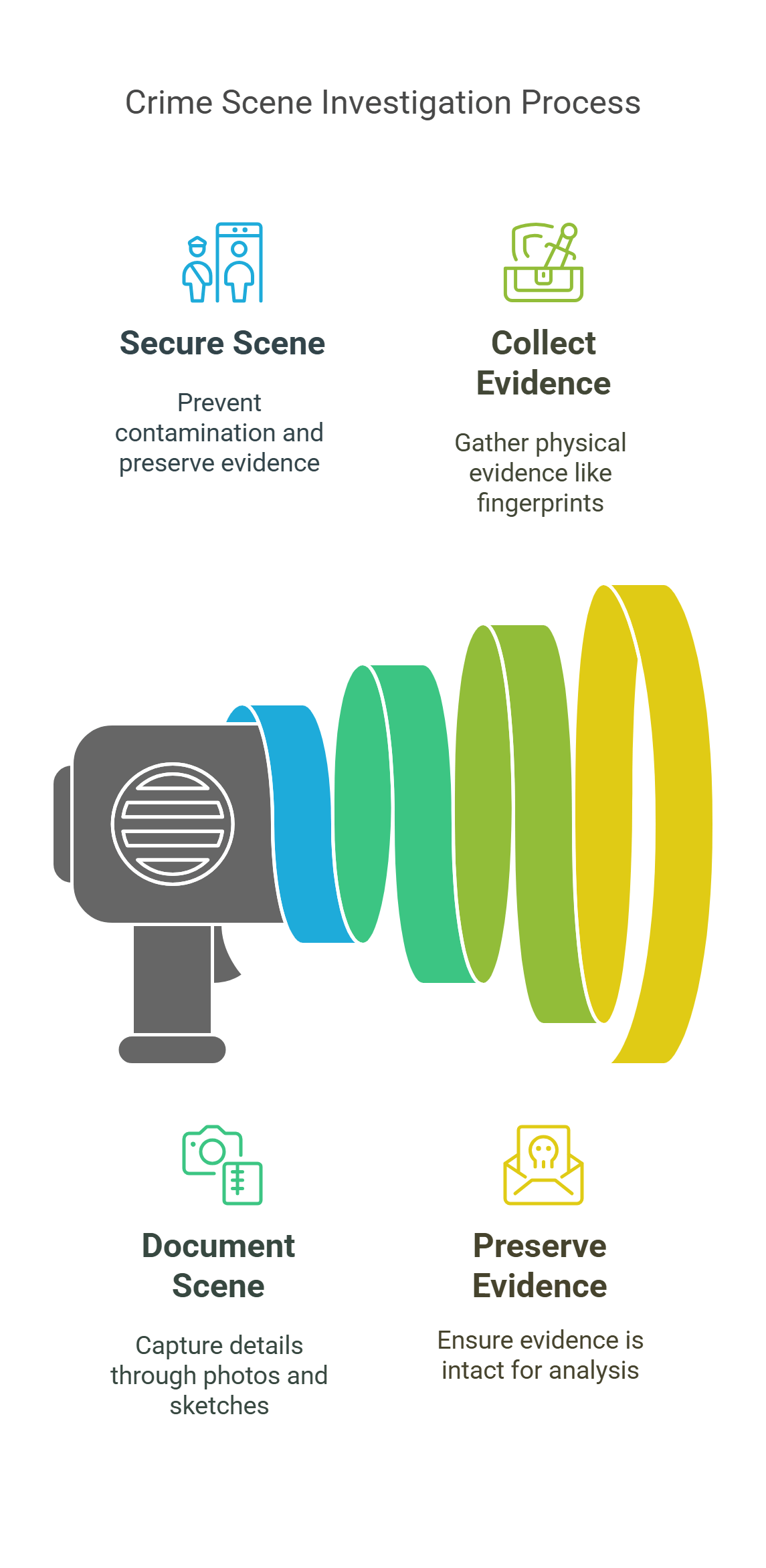
4. Ballistics
Ballistics examines firearms, ammunition, and bullet trajectories to determine details about a shooting incident. It helps establish the type of weapon used, the distance of firing, and whether a specific firearm was involved.
- Types of Ballistics:
- Internal Ballistics: Focuses on the behavior of a bullet inside the gun barrel.
- External Ballistics: Studies the bullet’s flight path after leaving the barrel.
- Terminal Ballistics: Examines the bullet’s impact on the target.
- Applications:
- Matching bullets or shell casings to a specific firearm using markings left during firing.
- Reconstructing shooting angles and distances.
Example: Ballistics analysis identified the rifle used in the assassination of President John F. Kennedy.
Explained Simply: Ballistics is like tracking a bullet’s journey to uncover its origin and impact.

5. Toxicology
Forensic toxicology examines bodily fluids and tissues to detect the presence of drugs, alcohol, poisons, or other substances. It helps determine whether toxic agents contributed to death or impaired behavior.
- Key Steps:
- Sample collection (e.g., blood, urine, hair).
- Chemical analysis using techniques like gas chromatography or mass spectrometry.
- Interpreting results to assess substance effects and concentrations.
- Applications:
- Identifying causes of drug overdoses or poisonings.
- Detecting performance-enhancing drugs in athletes.
- Establishing intoxication levels in DUI cases.
Example: Toxicology revealed cyanide poisoning as the cause of death in the Tylenol murders of 1982.
Explained Simply: Toxicology is like a chemical detective, uncovering what substances were in the body and their effects.
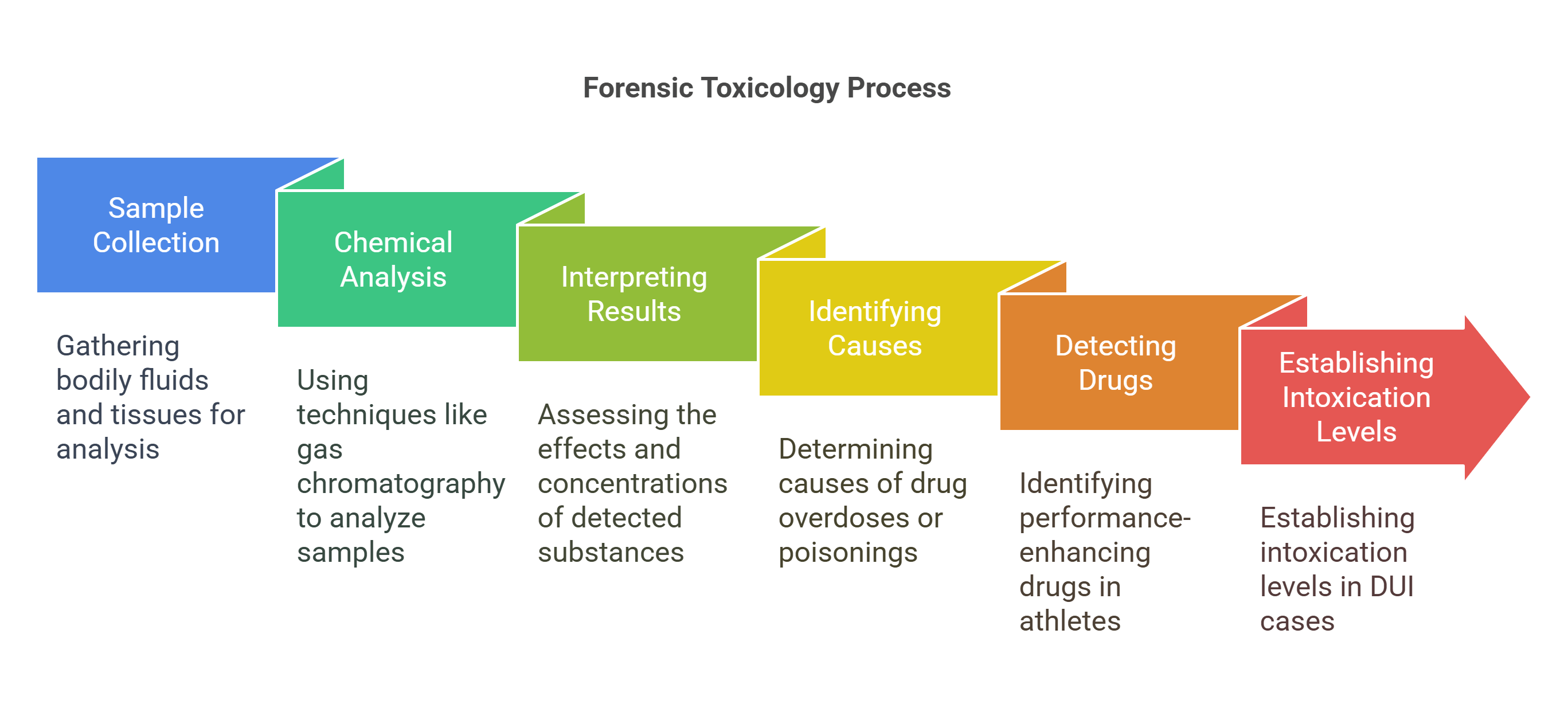
6. Trace Evidence
Trace evidence refers to tiny materials transferred during a crime, often invisible to the naked eye, which can link suspects, victims, and crime scenes. It includes fibers, hair, glass fragments, soil, paint, and more.
- Collection and Analysis:
- Collected using methods like vacuuming, adhesive tape, or tweezers.
- Analyzed using microscopes, spectrometry, and chemical tests to identify composition and origin.
- Applications:
- Matching fibers found on a victim to a suspect’s clothing.
- Identifying paint chips from a hit-and-run vehicle.
Example: In the Lindbergh kidnapping case, forensic scientists matched wood from a homemade ladder to the suspect’s home, using trace evidence as critical proof.
Explained Simply: Trace evidence is like forensic breadcrumbs, helping investigators follow the trail left behind.
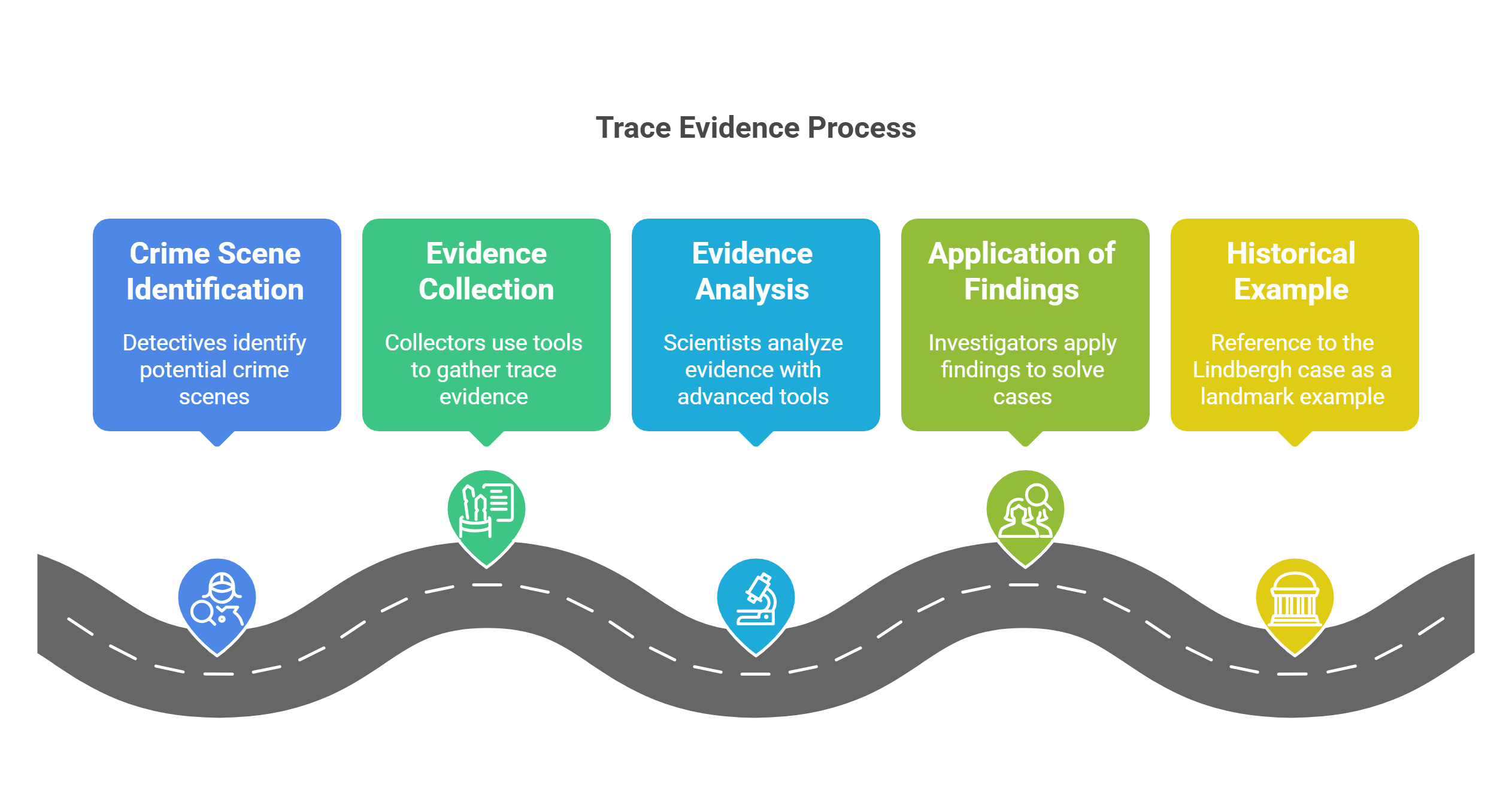
7. Digital Forensics
Digital forensics involves recovering, analyzing, and preserving electronic data from devices like computers, smartphones, and cloud servers to support criminal investigations.
- Key Areas:
- Computer Forensics: Examining hard drives for deleted files, emails, or browsing histories.
- Mobile Forensics: Retrieving data from smartphones, including messages, GPS locations, and app activity.
- Network Forensics: Investigating cybercrimes like hacking or unauthorized access to systems.
- Challenges:
- Encryption and advanced security features make data recovery complex.
- Rapidly evolving technology requires constant adaptation of forensic techniques.
Example: Digital forensics helped uncover key evidence in the Silk Road investigation, leading to the arrest of its operator, Ross Ulbricht.
Explained Simply: Digital forensics is like solving a mystery by decoding the digital footprints left behind.
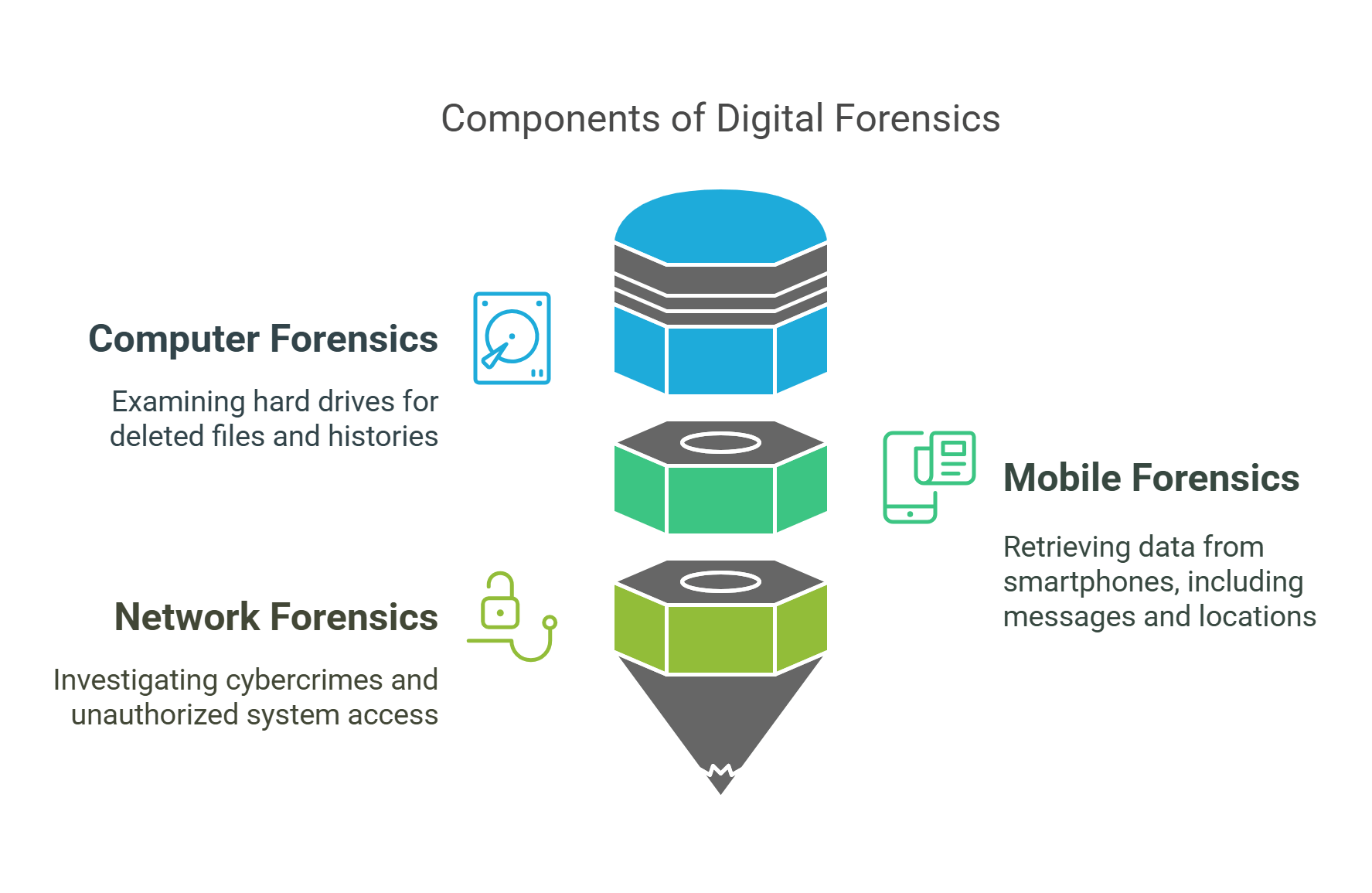
8. Post-Mortem Analysis
Post-mortem analysis, or autopsy, is a medical examination of a body to determine the cause, manner, and time of death. It provides critical insights for criminal investigations and public health concerns.
- Key Steps in an Autopsy:
- External Examination: Inspecting the body for visible injuries, marks, or abnormalities.
- Internal Examination: Examining organs and tissues for signs of disease, trauma, or poisoning.
- Toxicology Testing: Analyzing bodily fluids for drugs or toxins.
- Applications:
- Distinguishing between natural and unnatural causes of death.
- Identifying signs of foul play, such as strangulation or blunt force trauma.
Example: Autopsies played a critical role in uncovering the cause of death in high-profile cases like the death of Princess Diana.
Explained Simply: Post-mortem analysis is like reading a body’s final chapter to uncover the story behind its end.
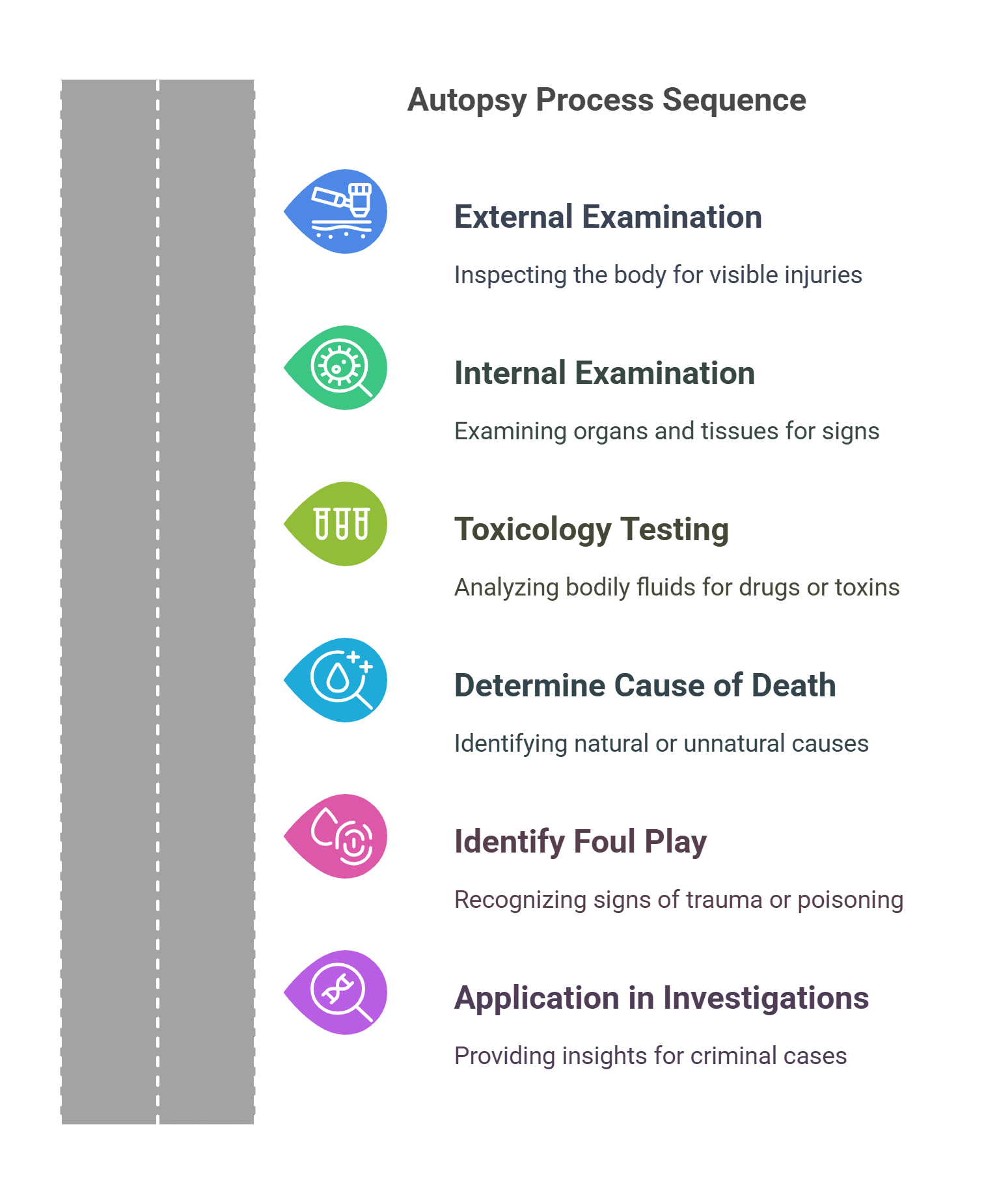
9. Chain of Custody
The chain of custody ensures that evidence collected during an investigation is properly documented, preserved, and handled to maintain its integrity and admissibility in court.
- Key Steps:
- Documentation: Recording when, where, and by whom evidence was collected.
- Secure Storage: Ensuring evidence is stored in tamper-proof containers.
- Transfer Logs: Keeping detailed records of every person who handles the evidence.
- Importance:
- Prevents contamination or tampering that could undermine the credibility of the evidence.
- Ensures accountability and transparency in the legal process.
Example: In the O.J. Simpson case, lapses in the chain of custody led to questions about the reliability of key evidence.
Explained Simply: The chain of custody is like a security system for evidence, protecting it every step of the way.
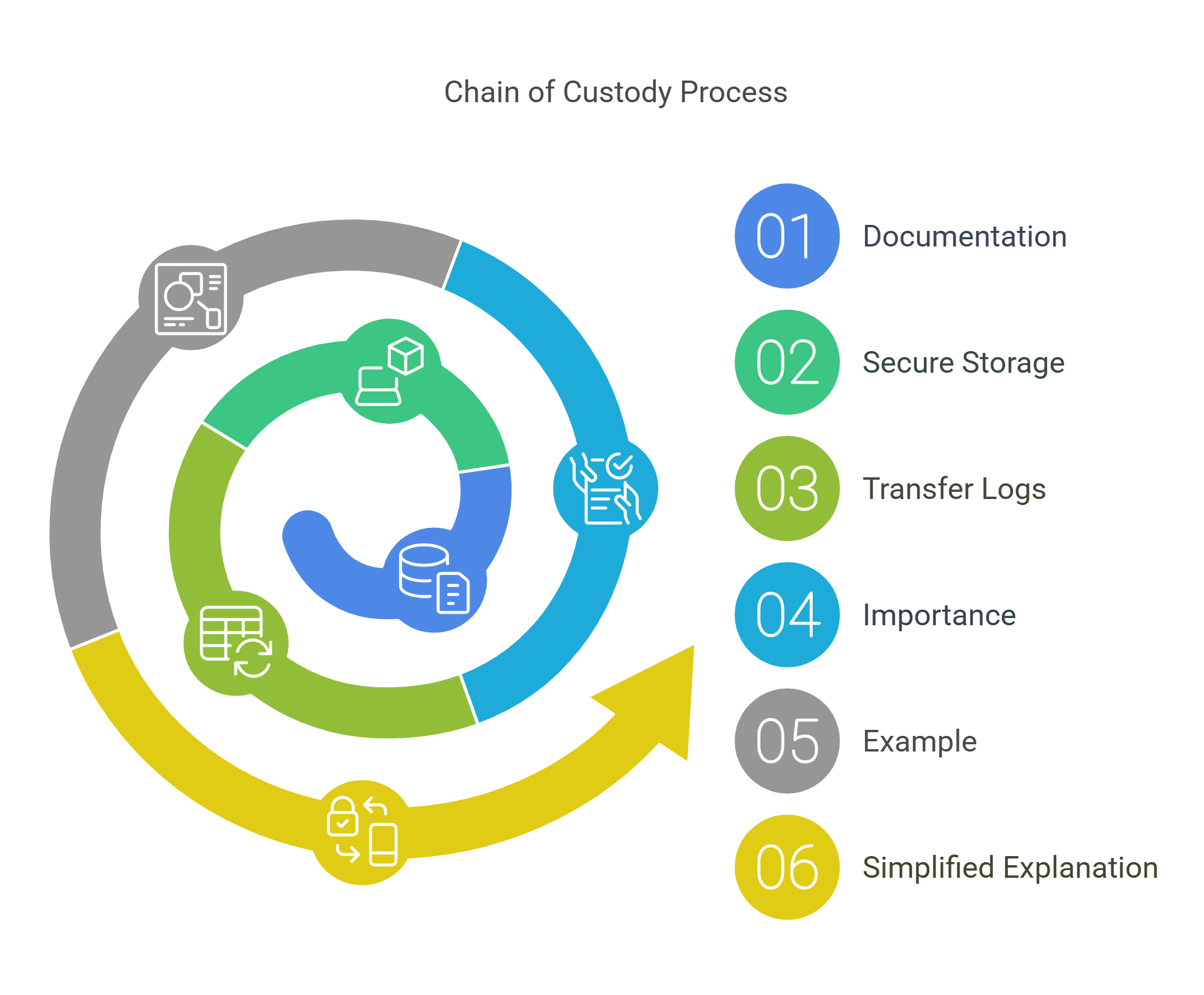
10. Blood Spatter Analysis
Blood spatter analysis examines the patterns, distribution, and shape of bloodstains at a crime scene to determine the events leading to the bloodshed. It provides critical insights into the weapon used, the angle of impact, and the positions of the victim and perpetrator.
- Types of Bloodstains:
- Passive Stains: Formed by gravity, such as drips or pools.
- Transfer Stains: Created when blood is smeared or transferred from one surface to another.
- Projected Stains: Result from force, such as arterial spurts or gunshot spatter.
- Key Questions Answered:
- Was the bloodshed consistent with the suspect’s or victim’s account?
- Was the blood pattern indicative of a struggle or self-inflicted injury?
Example: Blood spatter evidence was used to reconstruct events in the high-profile trial of Michael Peterson, as depicted in the documentary series The Staircase.
Explained Simply: Blood spatter analysis is like reading the splashes on a canvas to understand the story behind the scene.
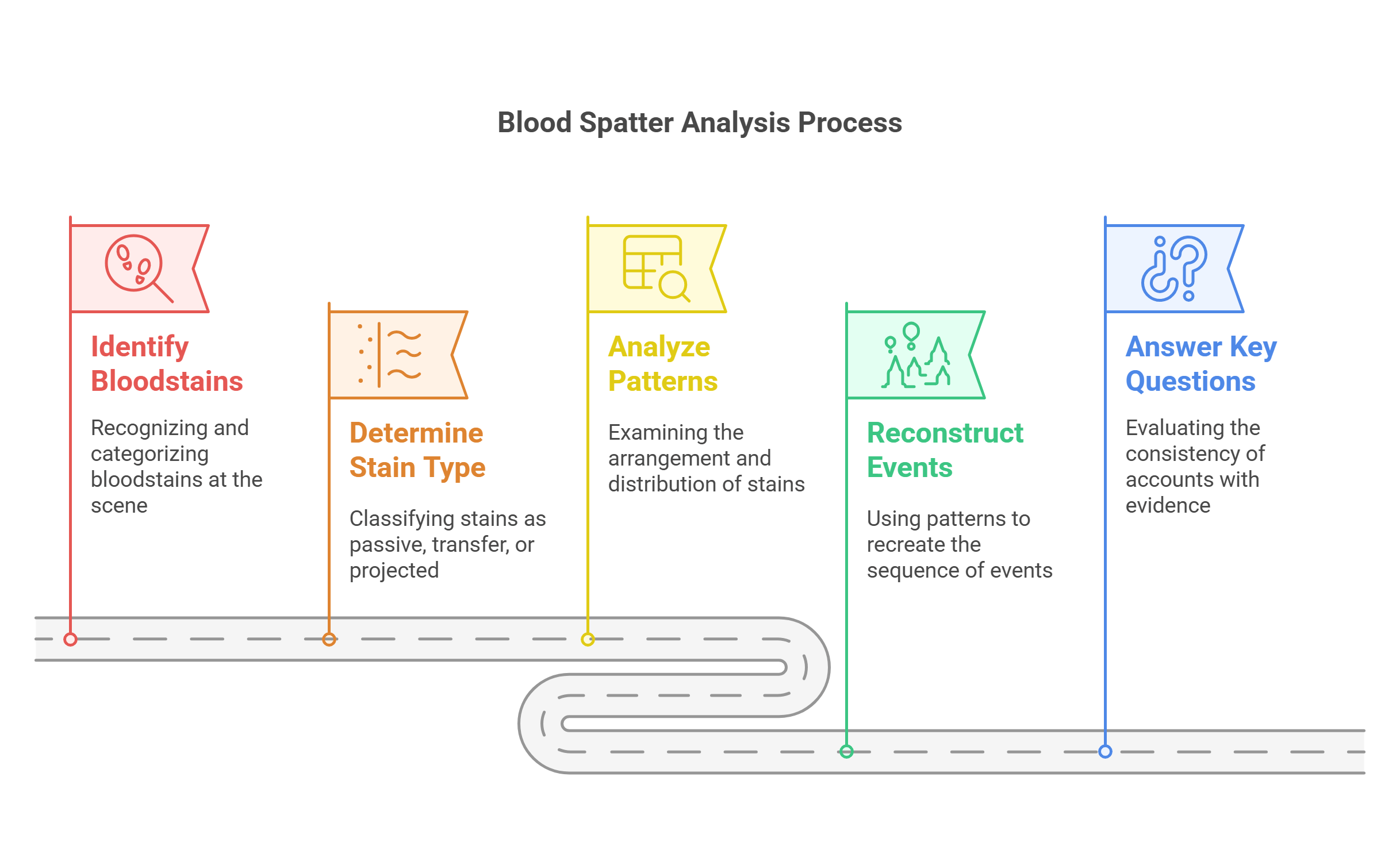
✨ Conclusion
Forensic science is an interdisciplinary field that transforms evidence into compelling narratives, solving crimes and supporting justice. By understanding concepts like DNA fingerprinting, digital forensics, and blood spatter analysis, readers can critically engage with RC passages and appreciate how science empowers the legal system.










